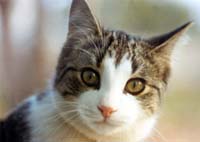H5N1 virus is evolving
Recently, there have been indications that the H5N1 virus has spread to domestic pets such as cats and pigs. This phenomenon forces scientists to warn against the evolving H5N1 virus, the risk of this "need to be carefully considered".

Cats - the closest pet in the family are at risk of becoming a bridge to infect the H5N1 virus.
Currently, avian influenza - the H5N1 virus strain has erupted in most parts of the world. According to statistics of the World Organization (WHO), more than 100 people died from the virus.
Scientists are trying their best to follow every step and find ways to prevent the development of this virus strain.
Evolution of the H5N1 virus
For the first time, since the emergence of the H5N1 virus strain that has spread to cats in 2004, 14 out of 15 cats have been killed by the H5N1 virus in a cat raising household near Bangkok. .
The cause of this infection is because a cat that has eaten the dead body of a chicken on a farm has an outbreak of H5N1 virus.
Next, cats in Indonesia, Thailand and Iraq also died from H5N1 infection. In particular, this infection has become popular among cats in Indonesia.
In March 2006, a cat died in Germany after being found to be infected with the H5N1 virus originating from wild birds.

Study of H5N1 virus in the laboratory ( Photo: Vrtnieuws )
Then the pigs on two farms in Banten province, near Jakarta, Indonesia, also died from the H5N1 virus in November 2005, where three people previously died from infection with the virus.
Most recently, the first bird flu appeared in wild animals by a German medical expert who discovered a marten ferret infected with the live H5N1 virus on Ruegen island in the Baltic Sea near where the three feline cats were infection with H5N1 virus.
In Scotland a swan bird died of H5N1 infection. Scientists have confirmed this is a kind of distortion of bird flu.
In addition, there are still reports of "big cats" (tigers) who also died of H5N1 infection - that is, 147 dead tigers in a Thai zoo after eating the meat of infected chickens. this type of virus.
H5N1 evolved: The risk of H5N1 infection from animals to humans

H5N1 is still stalking to attack people.( Photo: Press )
Scientists at Erasmus Medical Center, Rotterdam, Netherlands said. they do not have enough data and evidence to be able to determine whether the virus will continue to infect other mammals or evolve into a new strain of virus that can infect humans.
Scientists warn that anywhere in the world where the H5N1 virus is present, animals that eat infected birds will, at some point, lead to a risk of transmission to humans.
They do not want to exaggerate the risk of infection, but if that happens, health officials "need to carefully consider" the evolution of the virus.
The Asian Development Bank has decided to grant non-refundable aid to the Government of Vietnam of US $ 15 million to support the prevention of infectious diseases. The grant is part of a "Credit Prevention for the Greater Mekong Subregion" for the three countries in the region including Vietnam, Laos and Cambodia with a total value of nearly 39 million USD. In addition, Vietnam also received funding from the World Health Organization (WHO) worth $ 450,000 and the Government's counterpart fund is 4.55 million USD for this project. ( Source: VNA )
According to the search of Professor Peter Openshaw, Head of the Respiratory Infection Department at the Don Don College, he said that at the moment, animals almost go into the dead end of evolution.
The transmission of this strain is mainly through the intestines and lungs of animals, and there is no sign of self-secretion of the virus spreading to humans.
Even so, the most domestic pets are close animals like cats and rare birds that are the ones that infect people.
Therefore, the best way to prevent the risk of infection to that person is to isolate these animals.
According to the latest source, the World Health Organization and the World Veterinary Organization have chosen cats as a plan to conduct research, observe the role and infect the development of the H5N1 virus strain.
mystical gem
- Detection of the H5N1 virus strain by a test
- H5N1 flu appears in poultry in Ninh Thuan
- Restart studies of H5N1
- Cats infected with H5N1 virus?
- IAEA uses nuclear technology against H5N1 virus
- WHO announces the study of variant H5N1 avian influenza virus
- H5N1 avian influenza virus
- H5N1 virus lives for six days
- H5N1 can spread through the air
- The 9th death due to H5N1 infection in Cambodia
- Modified H5N1 virus can spread from pigs to humans
- The discovery of five mutations in H5N1 determines the spread
 March 2012: Launching H5N1 vaccine for poultry
March 2012: Launching H5N1 vaccine for poultry Experts comment on the mysterious gradual disappearance of the Delta variant in Japan
Experts comment on the mysterious gradual disappearance of the Delta variant in Japan Danger of the two Delta . branch variants
Danger of the two Delta . branch variants 2020 pandemic flu attack humans?
2020 pandemic flu attack humans? Why can't the flu virus be eradicated?
Why can't the flu virus be eradicated?  Garlic does not kill coronavirus
Garlic does not kill coronavirus  Does the corona virus stick to clothes, shoes, hair, papers?
Does the corona virus stick to clothes, shoes, hair, papers?  Top 10 things doctors recommend for living with SARS-CoV-2
Top 10 things doctors recommend for living with SARS-CoV-2  Vaccines to prevent future strains of Corona virus
Vaccines to prevent future strains of Corona virus  What you need to know about the virus that has a 70% mortality rate in India
What you need to know about the virus that has a 70% mortality rate in India 